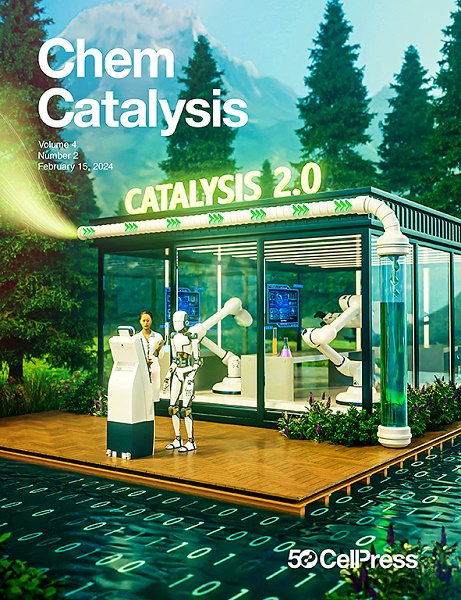Hinge loop reconstruction facilitates hydride transfer in Baeyer-Villiger monooxygenases
IF 11.5
Q1 CHEMISTRY, PHYSICAL
引用次数: 0
Abstract
To speed up biocatalytic redox reactions that use nicotinamide cofactors, previous researchers reshaped the cofactor-binding pocket, but this study focuses on the modification of a hinge loop outside the active site. This loop connects the FAD- and NADP-binding domains of AcPSMO (Acinetobacter calcoaceticus prazole sulfide monooxygenase). One penta-site mutant increased the catalytic efficiency with NADPH 87.5-fold more than the wild type, and another penta-site mutant increased the catalytic efficiency with NADH 12.9-fold more than the L143P mutant (the wild type was undetectable). These AcPSMO mutants also accepted two previously unreactive nicotinamide cofactor biomimetics as hydride donors. X-ray crystal structures and molecular dynamics simulations reveal that these substitutions move the bound NAD(P)H and FAD closer to one another. Introducing similar mutations in several other Baeyer-Villiger monooxygenases (BVMOs) also enhanced their catalytic activity. Thus, hinge-loop engineering is an effective alternative strategy to improve the reactivity of nicotinamide cofactors in BVMOs.

铰链环的重建促进了Baeyer-Villiger单加氧酶中的氢化物转移
为了加速使用烟酰胺辅助因子的生物催化氧化还原反应,以前的研究人员重塑了辅助因子结合袋,但本研究侧重于修饰活性位点外的铰链环。这个环连接AcPSMO(钙酸不动杆菌普拉唑硫化单加氧酶)的FAD-和nadp -结合域。其中一个五位点突变体的NADPH比野生型提高了87.5倍,另一个五位点突变体的NADH比野生型提高了12.9倍(野生型未检测到)。这些AcPSMO突变体也接受两种以前不反应的烟酰胺辅助因子作为氢化物供体。x射线晶体结构和分子动力学模拟表明,这些取代使结合的NAD(P)H和FAD彼此靠近。在其他几种Baeyer-Villiger单加氧酶(BVMOs)中引入类似的突变也增强了它们的催化活性。因此,铰链环工程是提高BVMOs中烟酰胺辅因子反应性的有效替代策略。
本文章由计算机程序翻译,如有差异,请以英文原文为准。
求助全文
约1分钟内获得全文
求助全文
来源期刊
CiteScore
10.50
自引率
6.40%
发文量
0
期刊介绍:
Chem Catalysis is a monthly journal that publishes innovative research on fundamental and applied catalysis, providing a platform for researchers across chemistry, chemical engineering, and related fields. It serves as a premier resource for scientists and engineers in academia and industry, covering heterogeneous, homogeneous, and biocatalysis. Emphasizing transformative methods and technologies, the journal aims to advance understanding, introduce novel catalysts, and connect fundamental insights to real-world applications for societal benefit.

 求助内容:
求助内容: 应助结果提醒方式:
应助结果提醒方式:


